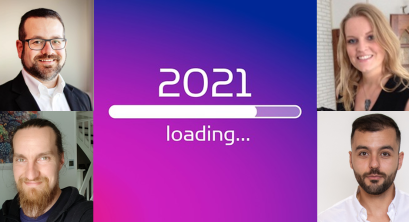What does 2021 have in store for the world of app marketing?
by Sukey Miller

The app industry has experienced a lot of change and growth in 2020, some anticipated, some totally unexpected! Millions have moved online for entertainment and education with lockdown restrictions, news of IDFA regulation changes reverberated across the advertising industry and subscription based streaming services experienced unprecedented global growth.
As 2020 draws to a close, we asked four industry experts what they think is in store for the world of app marketing in 2021. Here’s predictions from 5G game streaming platform Hatch, casual games publisher Tamlaki, monetization platform Telecoming and short-form mobile video platform TikTok.
What are the biggest challenges app developers will face in 2021?
Mike Gubman at ByteDance (TikTok): Uncertainty. 2021 will not be “business as usual”. App developers will need to carefully consider how to plan for COVID, Political and IDFA-related changes that create a very challenging environment for long-range planning.
Jussi Oja, Growth Marketer at Hatch: Amazon is now launching in the nordics. How will ad inventory react? Even if physical goods aren’t your main service and Amazon isn’t a direct competitor, there’s a risk of increases in UA costs. Amazon will probably capture its fair share of both market share and advertising space, but the existing players in the market will probably increase their advertising spend to fight back.
Martine Spaans, Owner at Tamalaki: The start of 2021 will bring a big change on the iOS side with the new IDFA policy. Luckily after the summer announcement we’ve had a couple more months to prepare for this change. I think it will be a matter of time before similar changes will be made on the Android side as well, as consumers are getting more and more aware of their online privacy.
Kristian Pechovski at Telecoming: Today’s online community dominates the digital environment, knows the risks and knows what it is looking for, focusing on what it wants and quickly discarding what it is not interested in. The gap between the heavy users and the rest of app users is tending to narrow. This change is due to the forced drive that 2020 has given to users who previously looked at technology with suspicion.
Apple, for example, seems to be getting rid of the IDFA opting developers to use the SKAdNetwork as an alternative. The developer community is sceptical about this change, which will question the future of attribution models in iOS. And this mature user demands products that follow the progress of the world. All proposals linked to social movements or trends have a place in the world of apps because users know what they want and what matters.
What do you think will be the biggest opportunity in 2021?
Mike Gubman at ByteDance: The new features of iOS 14 and Android 11, in conjunction with the desire for new 5G-capable flagship phones, should drive more app usage and discovery over the coming year. App Developers should be thinking about how to harness enthusiasm for App Clips, AR and other new features into more User Acquisition and engagement.
Jussi Oja, Growth Marketer at Hatch: I think the remote working and other changes to our purchasing behaviour brought on by the covid-19 are here to stay. Even when we slowly start to shift towards normal, it would be foolish to think that the working and consumption patterns that emerged during the year would suddenly go away. I think by far the most interesting opportunity of 2021 is tapping into that.
Another really interesting opportunity and or challenge is the post IDFA attribution on Apple. I think it’s going to pose a valuable opportunity for savvy marketeers who can take advantage of the changed mediascape and still price inventory effectively.
Martine Spaans, Owner at Tamalaki: Although browser games never died, the adaption for mobile devices has been a long slow process. Technically because it simply wasn’t possible to deliver the same quality as installed apps did, but also lack of convenience plays a part here.
Technical limitations are dwindling, and I do think we are getting to a point where browser content becomes a feasible alternative to the app stores. Not exactly a 2021 revolution, but perhaps something we’ll see unfolding more in the year to come.
Kristian Pechovski at Telecoming: On the technology side, the opportunity will undoubtedly come from the 5G. The new network will favour hyperconnectivity, which forces us to prepare ourselves to develop apps that are compatible with watches, but also cars and fridges. 5G opens the door to new experiences in terms of latency, graphic quality, immersion… it invites us to think about much more advanced technology.
And at the business level, without a doubt, the payment. This challenge of a conscious, demanding and hyperconnected user require us to develop liquid experiences where payments cannot be a barrier.
I look forward to Android and the updates that Google has recently implemented in its payment libraries for Google Play Store. These features allow the user to have very innovative payment alternatives. The possibility for a potential user to go to a physical store to purchase a subscription to an Android Play Store service through cash seems like it might also be a reality in the future. This will mean an apparent increase in the apps’ monetisation capacity for developers by offering other forms of payment that other stores do not provide.
If you could change anything in the app developer world going forward what would it be?
Mike Gubman at ByteDance: The entire industry is paying very close attention to how App Stores enforce their rules. Transparent, equally enforced rules are critical for a healthy ecosystem that benefits all parties.
Jussi Oja, Growth Marketer at Hatch: My humble wish, that I’m not expecting to be true anytime soon, is that the industry would get rid of the snake oil merchants overselling their capabilities or downright frauding the unsuspecting buyer. One can always hope 🙂
Martine Spaans, Owner at Tamalaki: I see great progress in terms of diversity. Not just in terms of content, but also within development teams. I remember an internal all-hands presentation from a company where I worked more than a decade ago. One of the slides showing a 12% female employee representation still got laughs and cheers. Today this kind of response is unimaginable. A lot of diversity initiatives are taken and slowly paying off. It may take another generation before everyone can feel represented, but the change is here to stay.
Kristian Pechovski at Telecoming: The complexity of the time we live and the speed of processes, I believe that many times, leave out potential developers who do not have the economic engine to keep up with the rhythms of this market. They are players who nevertheless have high capacities to develop extraordinary things. If there is one thing I am clear about, it is that talent and teamwork are the main driving forces behind any industry.
All the initiatives of large companies such as Apple, Google or Facebook, to support new talent and small development studios, are fundamental in order not to lose ideas along the way.
Subscribe to our newsletter
Get the latest subscription bundling news and insights delivered straight to your inbox.



